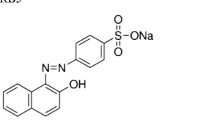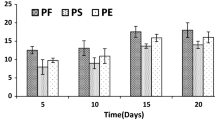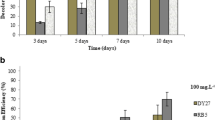Abstract
Decolorization and degradation of textile dye by endophytic fungi stand to be a profitable and viable alternative over conventional methods with respect to eco-friendliness, cost-effectiveness, and non-hazardous nature. One of the active fungal endophytes Colletotrichum gloeosporioides isolated from plant Thevetia peruviana (Pers.) K. Schum. was screened for laccase production and Congo red dye decolorization. Various physicochemical parameters like dye concentration, carbon sources, nitrogen sources, temperature, and pH were optimized, and the maximum decolorization (%) was achieved at 100 mg/L of dye concentration (82%), yeast extract (80%), 30 °C temp (80%), glucose (79%), and 7 pH (78%), respectively. SEM image and fungal biomass changes represent that fungus actively participated in the dye decolorization and had less significant effect on biomass. The regenerative ability of fungus C. gloeosporioides after dye decolorization indicated tolerance against the dye and was found to be more advantageous over previous reports of dye decolorization by other endophytic fungi. UV-Vis spectra, TLC, FTIR, and HPLC results confirmed the decolorization and degradation process due to absorption and biodegradation. Phytotoxicity assay depicted that degraded products are less toxic to Phaseolus mungo compared to Congo red. The overall findings showed that C. gloeosporioides possesses a good decolorization and degradation potential against Congo red and this endophyte can be profitably used for dye-containing wastewater treatment.








Similar content being viewed by others
References
Agrawal SCPK (2017) Decolorization of textile dye by laccase from newly isolated endophytic fungus Daldinia sp. Kavaka 48:33–41
Agrawal PK, Upadhyay P, Shrivastava R, Sharma S, Garlapati VK (2021) Evaluation of the ability of endophytic fungi from Cupressus torulosa to decolorize synthetic textile dyes. J Hazard Toxic Radioact Waste 25(1):06020005. https://doi.org/10.1061/(ASCE)HZ.2153-5515.0000569
Ajaz M, Rehman A, Khan Z, Nisar MA, Hussain S (2019) Degradation of azo dyes by Alcaligenes aquatilis 3c and its potential use in the wastewater treatment. AMB Express 9(1):1–2. https://doi.org/10.1186/s13568-019-0788-3
Argumedo-Delira R, Gómez-Martínez MJ, Uribe-Kaffure R (2021) Trichoderma biomass as an alternative for removal of congo red and malachite green industrial dyes. Appl Sci 11(1):448. https://doi.org/10.3390/app11010448
Arunprasath T, Sudalai S, Meenatchi R, Jeyavishnu K, Arumugam A (2019) Biodegradation of triphenylmethane dye malachite green by a newly isolated fungus strain. Biocatal Agric Biotechnol 17:672–679. https://doi.org/10.1016/j.bcab.2019.01.030
Bang S, Kim J, Oh J, Kim JS, Yu SR, Deyrup S, Shim SH (2022) Rare β-resorcylic acid derivatives from a halophyte-associated fungus Colletotrichum gloeosporioides JS0419 and their antifungal activities. Mar Drugs 20(3):195. https://doi.org/10.3390/md20030195
Barapatre A, Aadil KR, Jha H (2017) Biodegradation of malachite green by the ligninolytic fungus Aspergillus flavus. Clean 45(4):1600045. https://doi.org/10.1002/clen.201600045
Bulla LMC, Polonio JC, de Brito Portela-Castro AL, Kava V, Azevedo JL, Pamphile JA (2017) Activity of the endophytic fungi Phlebia sp. and Paecilomyces formosus in decolourisation and the reduction of reactive dyes cytotoxicity in fish erythrocytes. Environ Monit Assess 189(2):88. https://doi.org/10.1007/s10661-017-5790-0
Chakraborty S, Basak B, Dutta S, Bhunia B, Dey A (2013) Decolorization and biodegradation of Congo red dye by a novel white rot fungus Alternaria alternata CMERI F6. Bioresour Technol 147:662–666. https://doi.org/10.1016/j.biortech.2013.08.117
Chanzu HA, Onyari JM, Shiundu PM (2019) Brewers’ spent grain in adsorption of aqueous Congo red and malachite green dyes: batch and continuous flow systems. J Hazard Mater 380:120897
Chapla VM, Zeraik ML, Leptokarydis IH, Silva GH, Bolzani VS, Young MCM, Araújo AR (2014) Antifungal compounds produced by Colletotrichum gloeosporioides, an endophytic fungus from Michelia champaca. Molecules 19(11):19243–19252. https://doi.org/10.3390/molecules191119243
Desore A, Narula SA (2018) An overview on corporate response towards sustainability issues in textile industry. Environ Dev Sustain 20:1439–2145. https://doi.org/10.1007/s10668-017-99491
Dos Santos AB, Cervantes FJ, Van Lier JB (2007) Review paper on current technologies for decolourisation of textile wastewaters: perspectives for anaerobic biotechnology. Bioresour Technol 98(12):2369–2385. https://doi.org/10.1016/j.biortech.2006.11.013
El Bouraie M, El Din WS (2016) Biodegradation of reactive black 5 by Aeromonas hydrophila strain isolated from dye-contaminated textile wastewater. Sustain Environ Res 26(5):209–216. https://doi.org/10.1016/j.serj.2016.04.014
Faraco V, Pezzella C, Miele A, Giardina P, Sannia G (2009) Bio-remediation of colored industrial waste waters by the white-rot fungi Phanerochaete chrysosporium and Pleurotus ostreatus and their enzymes. Biodegradation 20(2):209–220. https://doi.org/10.1007/s10532-008-9214-2
Gahlout M, Gupte S, Gupte A (2013) Optimization of culture condition for enhanced decolorization and degradation of azo dye reactive violet 1 with concomitant production of ligninolytic enzymes by Ganoderma cupreum AG-1. 3 Biotech 3(2):143–152. https://doi.org/10.1007/s13205-012-0079-z
Gao T, Qin D, Zuo S, Peng Y, Xu J, Yu B, Dong J (2020) Decolorization and detoxification of triphenylmethane dyes by isolated endophytic fungus, Bjerkandera adusta SWUSI4 under non-nutritive conditions. Bioresour Bioprocess 7(1):1–12. https://doi.org/10.1186/s40643-020-00340-8
Gautam AK (2014) Colletotrichum gloeosporioides: biology, pathogenicity and management in India. J Plant Physiol Pathol 2(2):2–11. https://doi.org/10.4172/2329-955X.1000125
Gomi N, Yoshida S, Matsumoto K, Okudomi M, Konno H, Hisabori T, Sugano Y (2011) Degradation of the synthetic dye amaranth by the fungus Bjerkandera adusta Dec 1: inference of the degradation pathway from an analysis of decolorized products. Biodegradation 22(6):1239–1245. https://doi.org/10.1007/s10532-011-9478-9
Gonzaga LL, Costa LEO, Santos TT, Araújo EF, Queiroz MV (2015) Endophytic fungi from the genus C olletotrichum are abundant in the Phaseolus vulgaris and have high genetic diversity. J Appl Microbiol 118(2):485–496. https://doi.org/10.1111/jam.12696
Goud BS, Cha HL, Koyyada G, Kim JH (2020) Augmented biodegradation of textile azo dye effluents by plant endophytes: a sustainable, eco-friendly alternative. Curr Microbiol 77(11):3240–3255. https://doi.org/10.1007/s00284-020-02202-0 (Epub 2020 Sep 19)
Imran M, Crowley DE, Khalid A, Hussain S, Mumtaz MW, Arshad M (2015) Microbial biotechnology for decolorization of textile waste waters. Rev Environ Sci Biotechnol 14:73–92
Joshni TC, Subramaniam K (2011) Enzymatic degradation of azo dyes-a review. Int J Environ Sci 1(6):1250–1260
Kaushik P, Malik A (2009) Fungal dye decolourization: recent advances and future potential. Environ Int 35(1):127–141. https://doi.org/10.1016/j.envint.2008.05.010
Khandare RV, Govindwar SP (2015) Phytoremediation of textile dyes and effluents: current scenario and future prospects. Biotechnol Adv 33(8):1697–1714. https://doi.org/10.1016/j.biotechadv.2015.09.003
Kharwar RN, Mishra A, Gond SK, Stierle A, Stierle D (2011) Anticancer compounds derived from fungal endophytes: their importance and future challenges. Nat Prod Rep 28(7):1208–1228. https://doi.org/10.1039/c1np00008j
Khatri J, Nidheesh PV, Singh TA, Kumar MS (2018) Advanced oxidation processes based on zero-valent aluminium for treating textile wastewater. Chem Eng J 348:67–73
Kiiskinen LL, Kruus K, Bailey M, Ylösmäki E, Siika-Aho M, Saloheimo M (2004) Expression of Melanocarpus albomyces laccase in Trichoderma reesei and characterization of the purified enzyme. Microbiology 150(9):3065–3074. https://doi.org/10.1099/mic.0.27147-0
Lang W, Sirisansaneeyakul S, Ngiwsara L, Mendes S, Martins LO, Okuyama M, Kimura A (2013) Characterization of a new oxygen-insensitive azo-reductase from Brevibacillus laterosporus TISTR1911: toward dye decolorization using a packed-bed metal affinity reactor. Bioresour Technol 150:298–306. https://doi.org/10.1016/j.biortech.2013.09.124
Liu X, Zhou ZY, Cui JL, Wang ML, Wang JH (2021) Biotransformation ability of endophytic fungi: from species evolution to industrial applications. Appl Microbiol Biotechnol 105(19):7095–7113. https://doi.org/10.1007/s00253-021-11554-x
Marzall-Pereira M, Savi DC, Bruscato EC, Niebisch CH, Paba J, Aluízio R, Kava V (2019) Neopestalotiopsis species presenting wide dye destaining activity: report of a mycelium-associated laccase. Microbiol Res 228:126299. https://doi.org/10.1016/j.micres.2019.126299
Mishra VK, Passari AK, Chandra P, Leo VV, Kumar B, Uthandi S, Singh BP (2017) Determination and production of antimicrobial compounds by Aspergillus clavatonanicus strain MJ31, an endophytic fungus from Mirabilis jalapa L. using UPLC-ESI-MS/MS and TD-GC-MS analysis. PloS One 12(10):e0186234. https://doi.org/10.1371/journal.pone.0186234
Munck C, Thierry E, Gräßle S, Chen SH, Ting ASY (2018) Biofilm formation of filamentous fungi Coriolopsis sp. on simple muslin cloth to enhance removal of triphenylmethane dyes. J Environ Manage 214:261–266. https://doi.org/10.1016/j.jenvman.2018.03.025
Muthezhilan R, Vinoth S, Gopi K, Jaffar Hussain A (2014) Dye degrading potential of immobilized laccase from endophytic fungi of coastal sand dune plants. Int J Chemtech Res 6(9):4154–4160
Ngieng NS, Zulkharnain A, Roslan HA, Husaini A (2013) Decolourisation of synthetic dyes by endophytic fungal flora isolated from senduduk plant (Melastoma malabathricum). Int Sch Res Notices 2013:260730. https://doi.org/10.5402/2013/260730
Ortiz-Monsalve S, Valente P, Poll E, Jaramillo-García V, Henriques JAP, Gutterres M (2019) Biodecolourization and biodetoxification of dye-containing wastewaters from leather dyeing by the native fungal strain Trametes villosa SCS-10. Biochem Eng J 141:19–28. https://doi.org/10.1016/j.bej.2018.10.002
Parshetti G, Kalme S, Saratale G, Govindwar S (2006) Biodegradation of Malachite Green by Kocuria rosea MTCC 1532. Acta Chim Slov 53(4):492–498
Petrini O, Sieber TN, Toti L, Viret O (1993) Ecology, metabolite production, and substrate utilization in endophytic fungi. Nat Toxins 1(3):185–196. https://doi.org/10.1002/nt.2620010306
Pillai TG, Jayaraj R (2015) Colletotrichum gloeosporioides: a true endophyte of the endangered tree, Cynometra travancorica in the Western Ghats. J Plant Pathol Microbiol 6(5). https://doi.org/10.4172/2157-7471.1000267
Qu Y, Shi S, Ma F, Yan B (2010) Decolorization of reactive dark blue KR by the synergism of fungus and bacterium using response surface methodology. Bioresour Technol 101(21):8016–8023. https://doi.org/10.1016/j.biortech.2010.05.025
Rehman K, Shahzad T, Sahar A, Hussain S, Mahmood F, Siddique MH, Siddique MA, Rashid MI (2018) Effect of reactive black 5 azo dye on soil processes related to C and N cycling. Peer J 22(6):e4802
Rodriguez RJ, Redman RS, Henson JM (2004) The role of fungal symbioses in the adaptation of plants to high stress environments. Mitig Adapt Strateg Glob Chang 9(3):261–272
Salem SS, Mohamed A, El-Gamal M, Talat M, Fouda A (2019) Biological decolorization and degradation of azo dyes from textile wastewater effluent by Aspergillus niger. Egypt J Chem 62(10):1799–1813. https://doi.org/10.21608/EJCHEM.2019.11720.1747
Samuchiwal S, Gola D, Malik A (2021) Decolourization of textile effluent using native microbial consortium enriched from textile industry effluent. J Hazard Mater 402:123835. https://doi.org/10.1016/j.jhazmat.2020.123835
Saratale RG, Saratale GD, Chang JS, Govindwar SP (2011) Bacterial decolorization and degradation of azo dyes: a review. J Taiwan Inst Chem Eng 42(1):138–157. https://doi.org/10.1016/j.jtice.2010.06.006
Saratale RG, Gandhi SS, Purankar MV, Kurade MB, Govindwar SP, Oh SE, Saratale GD (2013) Decolorization and detoxification of sulfonated azo dye CI Remazol Red and textile effluents by isolated Lysinibacillus sp. RGS. J Biosci Bioeng 115(6):658–667. https://doi.org/10.1016/j.jbiosc.2012.12.009
Schulz B, Wanke U, Draeger S, Aust HJ (1993) Endophytes from herbaceous plants and shrubs: effectiveness of surface sterilization methods. Mycol Res 97(12):1447–1450. https://doi.org/10.1016/S0953-7562(09)80215-3
Sharma D, Goel G, Sud A, Chauhan RS (2015) A novel laccase from newly isolated Cotylidia pannosa and its application in decolorization of synthetic dyes. Biocatal Agric Biotechnol 4(4):661–666. https://doi.org/10.1016/j.bcab.2015.07.008
Sharma VK, Kumar J, Singh DK, Mishra A, Verma SK, Gond SK, Kharwar RN (2017) Induction of cryptic and bioactive metabolites through natural dietary components in an endophytic fungus Colletotrichum gloeosporioides (Penz.) Sacc. Front Microbiol 8:1126. https://doi.org/10.3389/fmicb.2017.01126
Sheik S, Bhagya N, Chandrashekar KR (2020) Cytotoxic and decolorizing potential of Colletotrichum gloeosporioides Penz., isolated from Salacia chinensis Linn. S Afr J Bot 134:146–150. https://doi.org/10.1016/j.sajb.2019.10.014
Sidhu AK, Agrawal SB, Sable VS, Patil SN, Gaikwad VB (2014) Isolation of Colletotrichum gloeosporioides, a novel endophytic laccase producing fungus from the leaves of a medicinal plant Piper betle. Int J Sci Eng 5:1087–1096
Sim JH, Khoo CH, Lee LH, Cheah YK (2010) Molecular diversity of fungal endophytes isolated from Garcinia mangostana and Garcinia parvifolia. J Microbiol Biotechnol 20(4):651–658. https://doi.org/10.4014/jmb.0909.09030
Singh DK, Kumar J, Sharma VK, Verma SK, Singh A, Kumari P, Kharwar RN (2018) Mycosynthesis of bactericidal silver and polymorphic gold nanoparticles: physicochemical variation effects and mechanism. Nanomed 13(2):191–207. https://doi.org/10.2217/nnm-2017-0235
Sun J, Guo N, Niu LL, Wang QF, Zang YP, Zu YG, Fu YJ (2017) Production of laccase by a new Myrothecium verrucaria MD-R-16 isolated from Pigeon Pea [Cajanus cajan (L.) Millsp.] and its application on dye decolorization. Molecules 22(4):673. https://doi.org/10.3390/molecules22040673
Tara N, Siddiqui SI, Rathi G, Chaudhry SA, Asiri AM (2020) Nano-engineered adsorbent for the removal of dyes from water: a review. Curr Anal Chem 16(1):14–40. https://doi.org/10.2174/1573411015666190117124344
Tigini V, Prigione V, Donelli I, Freddi G, Varese GC (2012) Influence of culture medium on fungal biomass composition and biosorption effectiveness. Curr Microbiol 64(1):50–59. https://doi.org/10.1007/s00284-011-0017-z
Uzma F, Mohan CD, Hashem A, Konappa NM, Rangappa S, Kamath PV, Abd Allah EF (2018) Endophytic fungi–alternative sources of cytotoxic compounds: a review. Front Pharmacol 9:309. https://doi.org/10.3389/fphar.2018.00309
Verma VC, Gond SK, Kumar A, Mishra A, Kharwar RN, Gange AC (2009) Endophytic actinomycetes from Azadirachta indica A. Juss.: isolation, diversity, and anti-microbial activity. Microb Ecol 57(4):749–756. https://doi.org/10.1007/s00248-008-9450-3
Verma VC, Kharwar RN, Gange AC (2010) Biosynthesis of antimicrobial silver nanoparticles by the endophytic fungus Aspergillus clavatus. Nanomedicine 5(1):33–40. https://doi.org/10.2217/nnm.09.77
Verma SK, Kumar A, Lal M, Debnath M (2015) Biodegradation of synthetic dye by endophytic fungal isolate of Calotropis procera root. Int J Appl Sci Biotechnol 3(3):373–380. https://doi.org/10.3126/ijasbt.v3i3.13136
Wang N, Chu Y, Zhao Z, Xu X (2017) Decolorization and degradation of Congo red by a newly isolated white rot fungus, Ceriporia lacerata, from decayed mulberry branches. Int Biodeterior Biodegradation 117:236–244. https://doi.org/10.1016/j.ibiod.2016.12.015
Weir BS, Johnston PR, Damm U (2012) The Colletotrichum gloeosporioides species complex. Stud Mycol 73:115–180. https://doi.org/10.3114/sim0011
Yu J, Zhang X, Tan T (2007) A novel immobilization method of Saccharomyces cerevisiae to sorghum bagasse for ethanol production. J Biotechnol 129(3):415–420. https://doi.org/10.1016/j.jbiotec.2007.01.039
Zhang PH, Yu XY, Weng LX, Sun LL, Mao ZC, Zhang YL (2019) Degradation of ferulic acid by the endophytic fungus Colletotrichum gloeosporioides TMTM-13 associated with Ostrya rehderiana Chun. ACS Omega 4(25):21000–21004. https://doi.org/10.1021/acsomega.9b02225
Zille A, Gornacka B, Rehorek A, Cavaco-Paulo A (2005) Degradation of azo dyes by Trametes villosa laccase over long periods of oxidative conditions. Appl Environ Microbiol 71(11):6711–6718. https://doi.org/10.1128/AEM.71.11.6711-6718.2005
Acknowledgements
The authors are thankful to the Head and Coordinator, CAS and DST-FIST in Botany, Institute of Science, BHU, Varanasi, India, for providing essential research facilities. The authors are thankful to CSIR and UGC, New Delhi, respectively, for providing the JRFs and SRFs.
Funding
RNK appreciates the SERB, DST, New Delhi, for the financial help (EEQ /2020/000549). The authors appreciably acknowledge the technical and minor financial helps of ISLS, UGC-UPE, DST-PURSE, IoE-BHU (R/Dev/D/IoE/Incentive/2020–21/32181), and Dept. of Chemistry, BHU, Varanasi, India, for technical support.
Author information
Authors and Affiliations
Contributions
Conceptualization: Rajnish Bharti, RN Kharwar, Monika Yadav, Arti Singh; Investigation: Rajnish Bharti, Jay Hind Nishad: Methodology: Rajnish Bharti, Veer Singh Gautam, Puja Kumari; Supervision: RN Kharwar; Writing original draft: Rajnish Bharti, Monika Yadav, Puja Kumari; Writing review and editing: Arti Singh, Jay Hind Nishad, RN Kharwar.
Corresponding author
Ethics declarations
Conflict of interest
The authors declare no competing interests.
Additional information
Publisher's Note
Springer Nature remains neutral with regard to jurisdictional claims in published maps and institutional affiliations.
Supplementary Information
Below is the link to the electronic supplementary material.
Rights and permissions
Springer Nature or its licensor (e.g. a society or other partner) holds exclusive rights to this article under a publishing agreement with the author(s) or other rightsholder(s); author self-archiving of the accepted manuscript version of this article is solely governed by the terms of such publishing agreement and applicable law.
About this article
Cite this article
Bharti, R., Yadav, M., Singh, A. et al. Evaluation of Congo red dye decolorization and degradation potential of an endophyte Colletotrichum gloeosporioides isolated from Thevetia peruviana (Pers.) K. Schum.. Folia Microbiol 68, 381–393 (2023). https://doi.org/10.1007/s12223-022-01017-9
Received:
Accepted:
Published:
Issue Date:
DOI: https://doi.org/10.1007/s12223-022-01017-9




